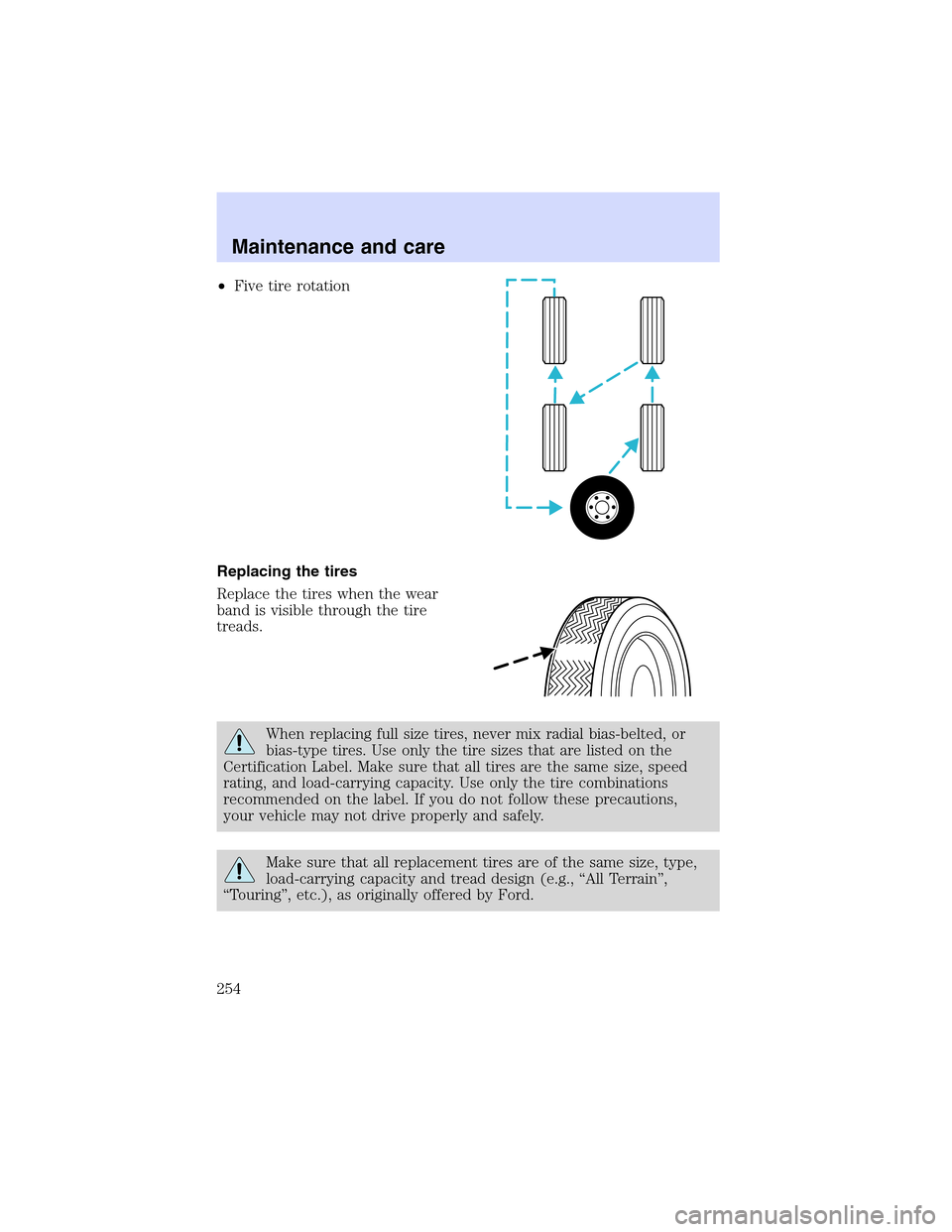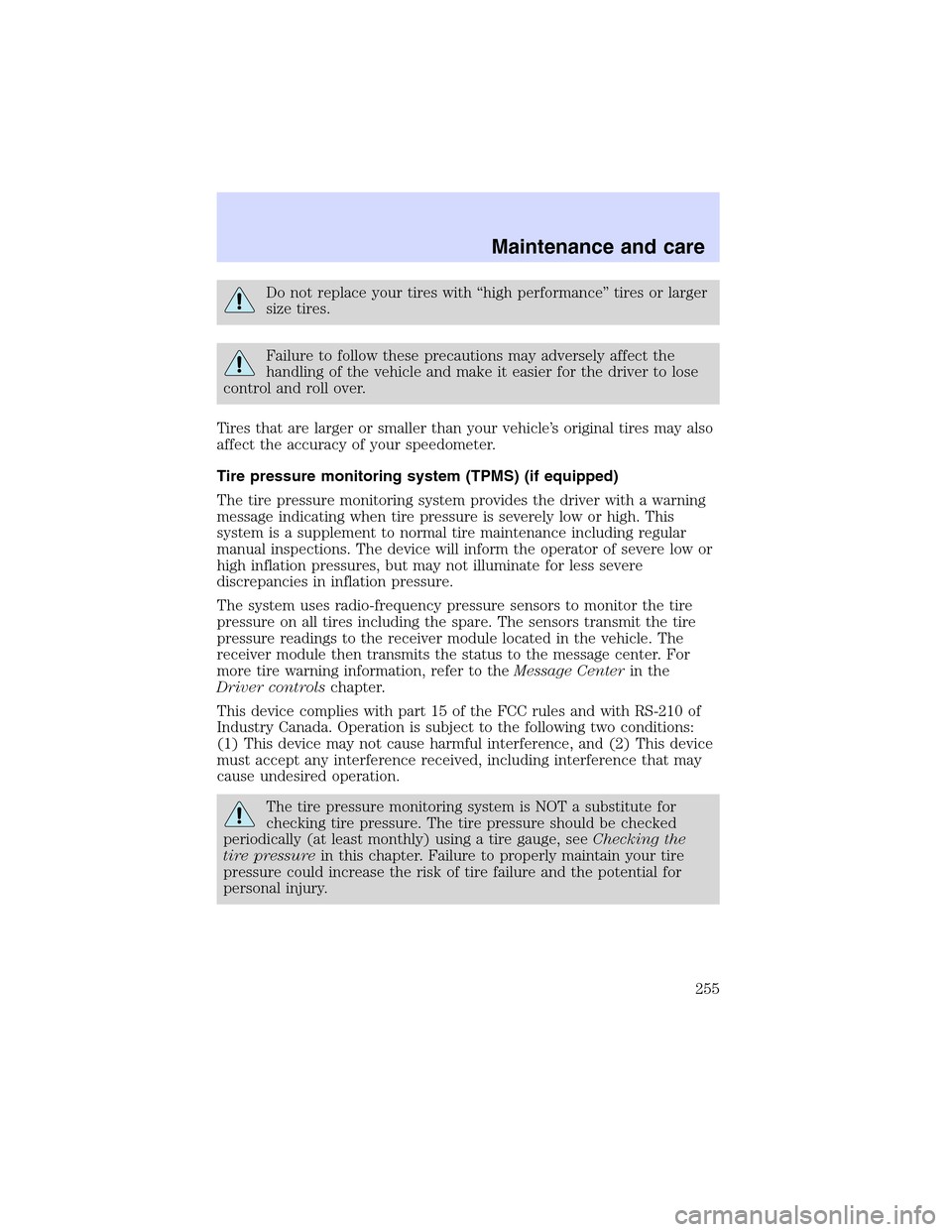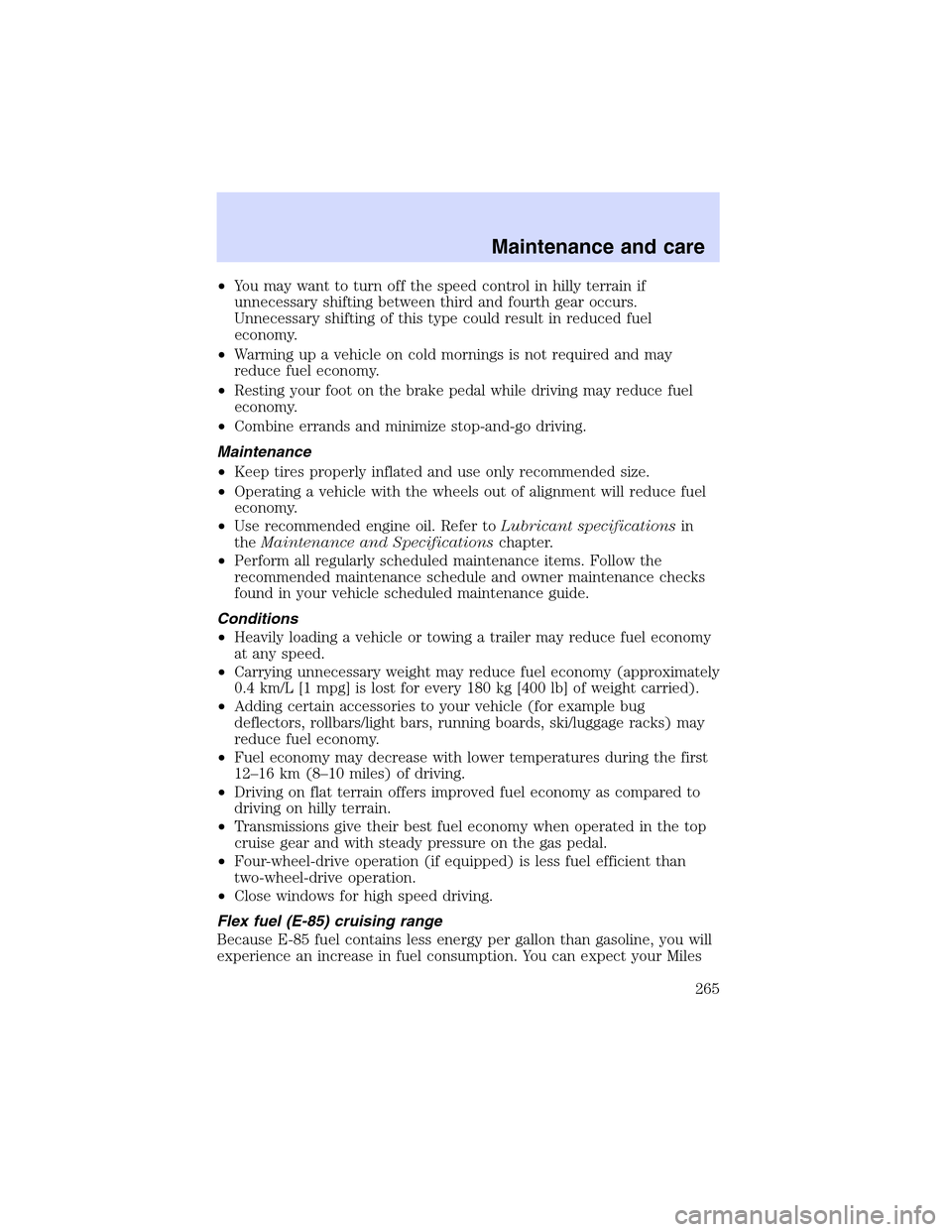tires Mercury Mountaineer 2002 s Owner's Guide
[x] Cancel search | Manufacturer: MERCURY, Model Year: 2002, Model line: Mountaineer, Model: Mercury Mountaineer 2002Pages: 312, PDF Size: 3.02 MB
Page 254 of 312

•Five tire rotation
Replacing the tires
Replace the tires when the wear
band is visible through the tire
treads.
When replacing full size tires, never mix radial bias-belted, or
bias-type tires. Use only the tire sizes that are listed on the
Certification Label. Make sure that all tires are the same size, speed
rating, and load-carrying capacity. Use only the tire combinations
recommended on the label. If you do not follow these precautions,
your vehicle may not drive properly and safely.
Make sure that all replacement tires are of the same size, type,
load-carrying capacity and tread design (e.g.,“All Terrain”,
“Touring”, etc.), as originally offered by Ford.
Maintenance and care
254
Page 255 of 312

Do not replace your tires with“high performance”tires or larger
size tires.
Failure to follow these precautions may adversely affect the
handling of the vehicle and make it easier for the driver to lose
control and roll over.
Tires that are larger or smaller than your vehicle’s original tires may also
affect the accuracy of your speedometer.
Tire pressure monitoring system (TPMS) (if equipped)
The tire pressure monitoring system provides the driver with a warning
message indicating when tire pressure is severely low or high. This
system is a supplement to normal tire maintenance including regular
manual inspections. The device will inform the operator of severe low or
high inflation pressures, but may not illuminate for less severe
discrepancies in inflation pressure.
The system uses radio-frequency pressure sensors to monitor the tire
pressure on all tires including the spare. The sensors transmit the tire
pressure readings to the receiver module located in the vehicle. The
receiver module then transmits the status to the message center. For
more tire warning information, refer to theMessage Centerin the
Driver controlschapter.
This device complies with part 15 of the FCC rules and with RS-210 of
Industry Canada. Operation is subject to the following two conditions:
(1) This device may not cause harmful interference, and (2) This device
must accept any interference received, including interference that may
cause undesired operation.
The tire pressure monitoring system is NOT a substitute for
checking tire pressure. The tire pressure should be checked
periodically (at least monthly) using a tire gauge, seeChecking the
tire pressurein this chapter. Failure to properly maintain your tire
pressure could increase the risk of tire failure and the potential for
personal injury.
Maintenance and care
255
Page 256 of 312

ChangingtireswithTPMS
It is recommended that you always
have your tires serviced by a dealer
or qualified technician.Each tire is
equipped with a tire pressure
sensor mounted on the wheel
inside the tire behind the valve
stem. The tire pressure sensor
must be unbolted from the wheel prior to tire removal. The
sensor can be removed by loosening the nut at the valve stem.
Failure to remove the sensor may damage it.The rubber grommet
(washer) between the wheel and the tire pressure sensor needs to be
replaced when any tire is changed to minimize air leaks.
The tire pressure should be checked periodically (at least monthly) using
a tire gauge, refer toChecking the tire pressurein this chapter.
USING SNOW TIRES AND TRACTION DEVICES
Snow tires must be the same size and grade as the tires you
currently have on your vehicle.
The tires on your vehicle have all-weather treads to provide traction in
rain and snow. However, in some climates, using snow tires or traction
devices may be necessary. Ford offers tire cables as a Ford approved
accessory and recommends use of these or SAE class“S”. See your
dealer or qualified service technician for more information on tire cables
for your vehicle.
Follow these guidelines when using snow tires and traction devices:
•Cables or chains should only be used on the rear wheels.
•Install cables or chains securely, verifying that the cables or chains do
not touch any wiring, brake lines or fuel lines.
•Drive cautiously. If you hear the cables or chains rub or bang against
the vehicle, stop and retighten them. If this does not work, remove the
cables or chains to prevent vehicle damage.
•Avoid overloading your vehicle.
•Remove the cables or chains when they are no longer needed.
•Do not use cables or chains on dry roads.
•Do not exceed 48 km/h (30 mph) with tire cables or chains on your
vehicle.
Maintenance and care
256
Page 265 of 312

•You may want to turn off the speed control in hilly terrain if
unnecessary shifting between third and fourth gear occurs.
Unnecessary shifting of this type could result in reduced fuel
economy.
•Warming up a vehicle on cold mornings is not required and may
reduce fuel economy.
•Resting your foot on the brake pedal while driving may reduce fuel
economy.
•Combine errands and minimize stop-and-go driving.
Maintenance
•Keep tires properly inflated and use only recommended size.
•Operating a vehicle with the wheels out of alignment will reduce fuel
economy.
•Use recommended engine oil. Refer toLubricant specificationsin
theMaintenance and Specificationschapter.
•Perform all regularly scheduled maintenance items. Follow the
recommended maintenance schedule and owner maintenance checks
found in your vehicle scheduled maintenance guide.
Conditions
•Heavily loading a vehicle or towing a trailer may reduce fuel economy
at any speed.
•Carrying unnecessary weight may reduce fuel economy (approximately
0.4 km/L [1 mpg] is lost for every 180 kg [400 lb] of weight carried).
•Adding certain accessories to your vehicle (for example bug
deflectors, rollbars/light bars, running boards, ski/luggage racks) may
reduce fuel economy.
•Fuel economy may decrease with lower temperatures during the first
12–16 km (8–10 miles) of driving.
•Driving on flat terrain offers improved fuel economy as compared to
driving on hilly terrain.
•Transmissions give their best fuel economy when operated in the top
cruise gear and with steady pressure on the gas pedal.
•Four-wheel-drive operation (if equipped) is less fuel efficient than
two-wheel-drive operation.
•Close windows for high speed driving.
Flex fuel (E-85) cruising range
Because E-85 fuel contains less energy per gallon than gasoline, you will
experience an increase in fuel consumption. You can expect your Miles
Maintenance and care
265
Page 309 of 312

fluid,checking and adding ....246
fluid, refill capacity ................282
fluid, specifications .........285, 287
Power Windows ...........................93
Preparing to drive your
vehicle ........................................180
R
Radio ......................................54, 63
Radio reception .....................76–77
Rear window defroster ...............53
Relays ................................206, 214
Remote entry system .......101, 103
illuminated entry ....................106
locking/unlocking
doors ................................102, 113
opening the trunk ...................103
panic alarm .............................103
replacement/additional
transmitters .............................105
replacing the batteries ...........104
Reverse sensing system .............33
Roadside assistance ..................204
Roof rack ...................................202
S
Safety belts (see Safety
restraints) ....13, 133, 135–138, 142
Safety Canopy ...................154–155
Safety defects, reporting ..........303
Safety restraints .......133, 135–138,
141–142
belt minder .............................143
cleaning the safety belts ........149
extension assembly ................142
for adults .........................136–138for children .............................158
lap belt ....................................139
warning light and
chime ...........................10, 13, 143
Safety seats for children ..........161
Seat belts (see Safety
restraints) ..................................133
Seats ..........................................120
child safety seats ....................161
heated ......................................124
memory seat ...................103, 123
SecuriLock passive anti-theft
system ................................116–118
Servicing your vehicle ..............229
Snowplowing .................................3
Spark plugs, specifications ......282,
287
Special notice ................................3
ambulance conversions ..............3
utility-type vehicles ....................3
Specification chart,
lubricants ...........................285, 287
Speed control ..............................78
Speedometer ...............................14
Starting your vehicle ........169, 171
jump starting ..........................222
Steering wheel
controls ..........................78, 82, 84
tilting .........................................82
T
Tachometer .................................16
Tire warning ..............................255
Tires ...................216, 251–253, 255
changing ..........................216, 218
checking the pressure ............253
Index
309
Page 310 of 312

replacing ..........................218, 254
rotating ....................................253
snow tires and chains ............256
spare tire .........................216–218
tire grades ...............................252
treadwear ................................252
Towing .......................................197
recreational towing .................201
trailer towing ..........................197
wrecker ....................................228
Traction control ........................177
active light ................................12
Transfer case
fluid checking .........................247
Transmission .............................181
fluid, checking and adding
(automatic) .............................247
fluid, refill capacities ..............282
lubricant specifications ..285, 287
Trip odometer .............................16
Trunk .........................................103
Turn signal ............................12, 77
V
Vehicle dimensions ...................287Vehicle Identification Number
(VIN) ..........................................289
Vehicle loading ..........................194
Ventilating your vehicle ...........173
W
Warning chimes ...........................13
Warning lights (see Lights) .........8
Washer fluid
..............................240
Water, Driving through
.............196
Windows
power
.........................................93
rear wiper/washer
.....................84
Windshield washer fluid and
wipers
checking and adding fluid
.....240
checking and cleaning
....250–251
liftgate reservoir
.....................240
operation
...................................83
replacing wiper blades
...........251
Wrecker towing
.........................228
Index
310